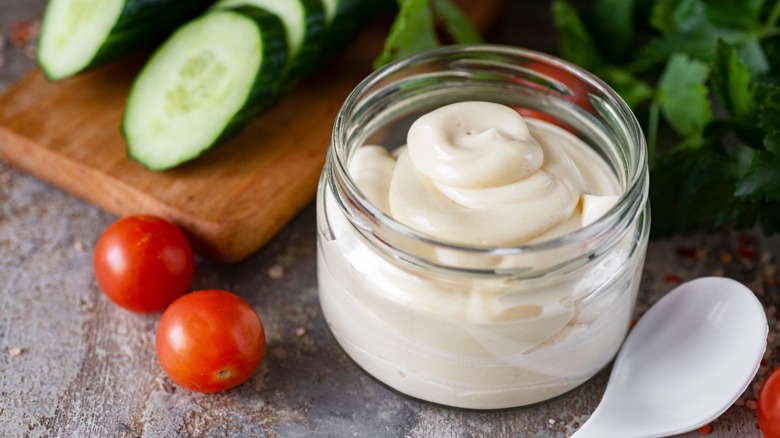
Homemade Mayonnaise: The Secret to a Perfect Emulsion
For many, the thought of making mayonnaise from scratch conjures images of culinary mishaps and wasted ingredients. Store-bought mayonnaise is readily available, and the fear of a separated, oily mess often deters adventurous home cooks. However, crafting your own mayonnaise is surprisingly simple, requiring just a few ingredients and a clever technique that guarantees success. The secret? A spoonful of Dijon mustard.
Why Make Your Own Mayonnaise?
Beyond the satisfaction of creating something delicious from scratch, homemade mayonnaise offers several advantages.
- Superior Taste: Freshly made mayonnaise boasts a brighter, cleaner flavor than its commercially produced counterparts. You have complete control over the ingredients, allowing you to tailor the taste to your exact preferences.
- Customization: Experiment with different oils, vinegars, and seasonings to create unique flavor profiles. Infuse your mayonnaise with herbs, spices, or even roasted garlic for a truly personalized condiment.
- Healthier Option: Many store-bought mayonnaises contain added sugars, preservatives, and artificial flavors. By making your own, you can avoid these unwanted additives and use high-quality ingredients.
- Impress Your Guests: Serving homemade mayonnaise adds a touch of sophistication to any meal. It's a simple way to elevate your culinary creations and impress your friends and family.
The Science of Emulsion: Why Mayonnaise Can Be Tricky
The challenge in making mayonnaise lies in creating a stable emulsion – a mixture of two liquids that don't normally combine, in this case, oil and water (from the vinegar or lemon juice). These liquids naturally repel each other, and without an emulsifier, they will quickly separate.
Egg yolks are the traditional emulsifier in mayonnaise. They contain lecithin, a natural compound with a unique molecular structure. One end of a lecithin molecule is attracted to oil, while the other end is attracted to water. This allows lecithin to bridge the gap between the oil and water molecules, holding them together in a stable emulsion.
The Dijon Mustard Advantage
While egg yolks provide the primary emulsification, adding Dijon mustard offers an extra layer of security. Mustard also contains lecithin, boosting the overall emulsifying power of the mixture. This makes the mayonnaise more resistant to separation, especially for beginners.
Furthermore, Dijon mustard has a relatively mild flavor that complements the other ingredients without overpowering them. Its subtle tanginess adds depth and complexity to the mayonnaise.
How to Make Foolproof Mayonnaise with Dijon Mustard
Whether you prefer the speed of an immersion blender or the traditional method of whisking by hand, incorporating Dijon mustard is a simple addition that will significantly improve your chances of success.
Ingredients:
- 1 large egg yolk (at room temperature)
- 1 tablespoon Dijon mustard
- 1 tablespoon lemon juice or vinegar (white wine vinegar or apple cider vinegar work well)
- 1 cup neutral-tasting oil (such as canola, grapeseed, or light olive oil)
- Salt and pepper to taste
Instructions (Immersion Blender Method):
- In a jar or container that fits your immersion blender, combine the egg yolk, Dijon mustard, and lemon juice (or vinegar).
- Place the immersion blender at the bottom of the jar, ensuring the blades are fully submerged.
- Slowly pour the oil into the jar on top of the other ingredients.
- Turn on the immersion blender and hold it still at the bottom of the jar for about 20 seconds, until the mixture begins to emulsify and turn pale.
- Slowly move the immersion blender up and down in the jar, incorporating the remaining oil until the mayonnaise is thick and creamy.
- Season with salt and pepper to taste.
Instructions (Hand Whisk Method):
- In a medium bowl, whisk together the egg yolk, Dijon mustard, and lemon juice (or vinegar).
- Very slowly, begin adding the oil, drop by drop, while whisking constantly and vigorously. This is crucial for the initial emulsion to form.
- As the mixture thickens, you can gradually increase the rate at which you add the oil, but continue to whisk constantly.
- Once all the oil is incorporated and the mayonnaise is thick and creamy, season with salt and pepper to taste.
Tips for Success
- Use room temperature ingredients: This helps the emulsion form more easily.
- Add the oil slowly: Especially at the beginning, adding the oil too quickly can cause the mayonnaise to separate.
- Don't over-process: Once the mayonnaise is thick and creamy, stop mixing to avoid breaking the emulsion.
- Store properly: Homemade mayonnaise should be stored in an airtight container in the refrigerator and consumed within a week.
Beyond the Basics: Flavor Variations
Once you've mastered the basic recipe, feel free to experiment with different flavors.
- Garlic Aioli: Add minced garlic or roasted garlic to the mayonnaise for a flavorful aioli.
- Herb Mayonnaise: Incorporate fresh herbs like dill, parsley, or chives for a vibrant and aromatic mayonnaise.
- Spicy Mayonnaise: Add a pinch of cayenne pepper, sriracha, or chipotle powder for a spicy kick.
- Lemon-Dill Mayonnaise: Combine lemon zest and fresh dill for a bright and refreshing mayonnaise perfect for seafood.
With a little practice and the secret ingredient of Dijon mustard, you can easily create delicious, homemade mayonnaise that rivals the best store-bought brands. Enjoy the fresh flavor and the satisfaction of knowing exactly what goes into your food.


No comments:
Post a Comment